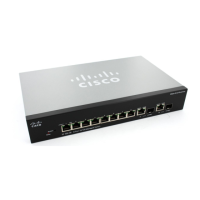VLAN Management
GVRP Settings
Cisco Small Business 300 Series Managed Switch Administration Guide 118
11
The Port VLAN Membership page displays the operational membership of the
ports or LAGs:
• Port number.
• Mode—Port mode defined in the Interface Settings Page.
• PVID—Port VLAN Identifier of the VLAN to which incoming untagged frames
are assigned at ingress. This assumes that no other VLAN assignment
mechanism is used, such as MAC-based-VLAN.
• VLANs—VLAN to which the port belongs.
GVRP Settings
Adjacent VLAN-aware devices can exchange VLAN information with each other
by using Generic VLAN Registration Protocol (GVRP). GVRP is based on the
Generic Attribute Registration Protocol (GARP) and propagates VLAN information
throughout a bridged network.
Since GVRP requires support for tagging, the port must be configured in Trunk
mode or General mode.
When a port joins a VLAN by using GVRP, it is added to the VLAN as a dynamic
member, unless this was expressly forbidden in the VLAN To Port Page. If the
VLAN does not exist, it is dynamically created when Dynamic VLAN creation is
enabled for this port.
GVRP must be activated globally as well as on each port. When it is activated, it
transmits and receives GARP Packet Data Units (GPDUs). VLANs that are defined
but not active are not propagated. To propagate the VLAN, it must be up on at least
one port.
Defining GVRP Settings
To define GVRP settings for an interface:
STEP 1 Click VLAN Management > GVRP Settings. The GVRP Settings Page opens.
STEP 2 Select GVRP Global Status to enable GVRP globally.
STEP 3 Click Apply to set the global GVRP status.

